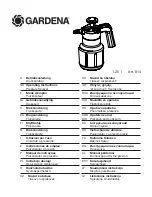
3
Caution signals a hazard that may cause minor or
moderate injury if you do not follow the recommended
precautions.
This manual uses two other words to highlight
information.
Important
calls attention to special
mechanical information and Note: emphasizes general
information worthy of special attention.
Safety
Improper use or maintenance by the operator or owner
can result in injury. To reduce the potential for injury,
comply with these safety instructions and always pay
attention to the safety alert
symbol, which means
CAUTION, WARNING, or DANGER—“personal
safety instruction.” Failure to comply with the
instruction may result in personal injury or death.
Safe Operating Practices
The WORKMAN equipped with a spray system is
an off-highway vehicle only and is not designed,
equipped, or manufactured for use on public
streets, roads, or highways.
Warning
The WORKMAN
was designed and tested to offer
safe service when operated and maintained properly.
Although hazard control and accident prevention
partially are dependent upon the design and
configuration of the machine, these factors are also
dependent upon the awareness, concern, and proper
training of the personnel involved in the operation,
maintenance and storage of the machine. Improper use
or maintenance of the machine can result in injury or
death.
This is a specialized utility vehicle designed for
off–road use only. Its ride and handling will have a
different feel than what drivers experience with
passenger cars or trucks. So take time to become
familiar with your WORKMAN
.
Not all of the attachments that adapt to the
WORKMAN
are covered in this manual. See the
specific Operator’s Manual provided with attachment
for additional safety instructions. READ THESE
MANUALS.
TO REDUCE THE POTENTIAL FOR INJURY OR
DEATH, COMPLY WITH THE FOLLOWING
SAFETY INSTRUCTIONS.
Supervisor’s Responsibilities
•
Make sure that operators are thoroughly trained and
familiar with the Operator’s Manual, Training Video,
Engine Manual, and all labels on the Workman
vehicle.
•
Be sure to establish your own special procedures and
work rules for unusual operating conditions (e.g.
slopes too steep for vehicle operation). Use the 3rd
High Lockout switch if high speed could result in a
safety or vehicle abuse situation.
Chemical Safety
Chemicals are hazardous and can injure you,
bystanders, animals, plants, soils, or other
property.
•
Carefully read and follow the chemical
manufacturer’s instructions for the safe
preparation, use, and disposal of the chemical.
•
Keep chemicals off of your and bystander’s
skin. If contact should occur, wash it off
immediately with clean water and detergent.
•
Wear goggles and other protective equipment
as instructed by the chemical manufacturer.
Warning
•
Obtain proper training before using or handling
chemicals.
•
Use the correct chemical for the job.
•
Follow the chemical manufacturer’s instructions for
the safe application of the chemical.
•
Handle chemicals in a well ventilated area.
•
Wear goggles and other protective equipment as
instructed by the chemical manufacturer. Ensure that
as little skin as possible is exposed while using
chemicals.
•
Have clean water available especially when filling the
spray tank.
•
Do not eat, drink, or smoke while working with
chemicals.
•
Always wash your hands and other exposed areas as
soon as possible after finishing the work.
•
Properly dispose of unused chemicals and chemical
containers as instructed by the chemical manufacturer
and your local codes.
•
Chemicals and fumes in the tanks are dangerous; never
enter the tank or place your head over or in the
opening.




































